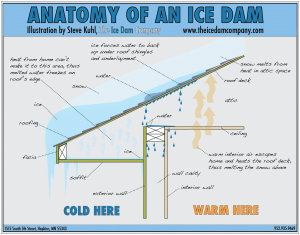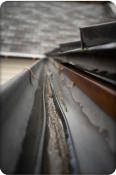Heated Gutters in Morristown, NJ
Using Heat Tape To Create A Heated Gutter
A heated gutter system consists of a gutter combined with self-regulating heat tape that is threaded through the gutters and downspouts beneath a gutter guard. This heat tape gently warms the gutter during the winter, helping to prevent issues that can arise from snow and ice accumulation.
Talk to us about Heated Gutters Today!
Why Heated Gutters?
If you own a home in a colder climate, you’re probably familiar with the persistent worry that ice dams could form on your roof and lead to leaks. Water damage from these leaks can quickly become a significant emotional and financial headache.
Harsh winter conditions often worsen the problem, sometimes resulting in significant repair bills when ice damming occurs. Large icicles that form along the edge of your roof, especially above walkways and driveways, can also become hazardous during the winter. In more severe cases, the weight of accumulated snow and ice may even cause your gutters to crack, pull away from the house, or collapse entirely.
Many homeowners choose to install heat tape on their gutters to help prevent these issues and gain peace of mind. This specialized cable gently warms up to melt snow and ice, effectively reducing the risk of ice dams without causing any harm to your home.
What About Heated Tape on the Roof?
Unlike traditional roof heat cables that are placed on top of the roof and run along its edge, our approach involves installing heated gutter cables-also known as heat tape-inside the gutters, just beneath a gutter guard system, as well as inside the downspouts. This setup, which combines heated gutters with heated gutter guards, effectively addresses many of the issues that arise with standard roof heat tape or cable installations.
The real value of installing heat tape depends entirely on proper installation. Many companies use a zigzag or triangle pattern on the first three feet of the roof, then run the cable inside the gutter and downspout. While this method can melt snow and ice on the roof, it does not prevent ice dams from forming in or on the gutters. As a result, ice can still accumulate and clog the drains, restricting water flow and leading to further problems.
Moreover, research has shown that installing heat tape directly on the roof can cause more long-term damage than not using any cable, and it may even void your roof’s warranty.
Heat Tape works better inside a Gutter System
We use Weather-Ready heat tape, which is installed exclusively inside the gutters and downspouts to avoid affecting the shingles and protect the heat tape. This approach ensures that only the gutters are heated, resulting in effective performance and an attractive appearance. When paired with a gutter guard, the heat from the tape is trapped inside, keeping the entire gutter system warm. As snow on the roof melts, it encounters a warm gutter guard and gutter, which prevents ice and snow from accumulating in the system. This means your gutters only need to handle water, not ice.
For the best results, turning on the heat cable just before snowfall begins is important. Heated cables are especially important in regions with harsh winters and heavy snowfall, as they help prevent ice dams and keep water from entering your home.
Snow Guards
Snow Guards, which should not be mistaken for Gutter Guards, are valuable features for roofs in regions with significant snowfall. Their primary purpose is to prevent snow or ice from suddenly sliding off the roof in an avalanche-like manner, helping to protect landscaping and pedestrians below from potential harm.
Ice Dams
Ice dams typically form when roof insulation is uneven or insufficient or when other factors cause temperature fluctuations that melt snow on the roof. As the melted snow runs down the roof, it refreezes upon reaching the colder sections over the eaves. This process causes ice to accumulate at the roof’s edge or in the gutters, which traps even more ice and water above it. As a result, water can back up under the shingles and eventually seep into your attic, ceilings, and interior walls. This water intrusion can cause costly damage to your home and may even require mold remediation.
What Causes Ice Damming?
There are a variety of reasons behind this problem. The most common reasons for ice damming are:

The pitch of a roof plays a significant role in how quickly ice damming can develop, with lower-pitched roofs being more susceptible. Many homeowners notice ice damming around bathroom vents and chimneys, where temperature fluctuations are typical.
Traditional roof heat cables are often installed on top of the roof, exposing them. However, these cables don’t always solve the problem; ice can still form above the heat tape, pushing the issue further up the roof where the protective benefits of the drip edge and ice/water shield are no longer present. When the heat tape does manage to melt snow, the resulting water may refreeze as it moves down toward the gutter, since gutters are typically colder than the roof due to being surrounded by cold air.
A heated gutter system addresses this by warming the entire gutter, preventing refreezing and eliminating the issue. In the absence of a heated gutter, ice commonly builds up in the gutters first, often leading homeowners to wonder whether gutters are responsible for causing ice dams.
Why Gutter Guards are an important part of a Heated Gutter System?
Gutter guards not only prevent leaves and debris from clogging your gutters, but they also add strength to the gutter system, protect the heat cable, and help keep snow out so it melts more quickly. When heat tape is installed inside the gutter, it warms the entire system, allowing snow to melt as it falls and reducing the risk of ice buildup that could cause water to enter your home or create large, dangerous icicles hanging from your roof or gutters. If the heat cable is left exposed to the elements, it can become damaged, and leaves and debris are more likely to get caught on it.
Are Heated Gutters Safe? What about potential fire hazards?
The Nuheat Weather-Ready heat tape installed by The Brothers that just do Gutters features a UV-resistant polyolefin outer jacket, a tinned copper braided layer, and a fire-resistant conductive core. For additional safety, Nuheat requires ground-fault protection on each heating cable circuit to help prevent fire risks associated with continuous electrical arcing that could result from improper installation or damage to the cable. A licensed electrician may be needed to complete the final connection in certain situations. Placing heat cable directly on the roof’s surface, however, can pose a potential fire hazard.
How much electricity does it use?
Your actual electrical usage will depend on the length of the cable run, as this affects how much power is consumed. The Nuheat Weather-Ready heat tape is designed to self-regulate its power output based on the surrounding conditions. When the ambient temperature drops and there is ice or snowfall, the heat tape increases its power output to provide more heat. Conversely, as the temperature of the water and ice rises, the heat tape reduces its wattage and emits less heat. For further information, you can refer to our page on the cost of heated gutter systems.
Heated Gutter Demonstration
We put together a video demonstration of how a heated gutter system works. We placed piles of snow on top of the gutters so that viewers can see them melt through a time-lapse video.
For best results, your heat cable should be turned on prior to the snowstorm… so that the heated gutter will melt the snowflakes as they land. Once there is an accumulation of ice or snow, it will melt but takes more time and energy.
Note: For this simulation, we started with a mound of snow already on the gutter; during an actual snowstorm the flakes will melt as they land on the heated gutter. Be sure to visit our many blogs on this topic.
Installing Heat Tape – Using Heat Tape To Create A Heated Gutter
When installing heat tape, several important factors should be taken into account. Spacing is crucial and will vary depending on the roof’s pitch and the length of the soffit. The heated cable is typically placed inside your gutters and downspouts, with the most effective approach being to install the heat cable beneath a gutter guard. Using a gutter guard is highly recommended, as it not only protects the cable but also helps retain heat, making the entire system work more efficiently and reducing the risk of problems caused by ice dams.
To supply power to the heat tape, you can connect a premade length of heat tape or a GFCI plug-in cord set to an existing outdoor outlet, which avoids the need for hardwiring. However, if there is no suitable outdoor outlet available or if your setup requires a different solution, it may be necessary to consult an electrician to complete the power hookup safely.
Table of Contents
Why Heated Gutters?
What about Heat Tape on the Roof?
Heat Tape works better inside a Gutter System
Snow Guards
Ice Dams
What Causes Ice Damming?
Why Gutter Guards are an important part of a Heated Gutter System?
Are Heated Gutters Safe? What about potential fire hazards?
How much electricity does it use?
Heated Gutter Demonstration
Installing Heat Tape
Talk to us about Heated Gutters Today!
Design the Perfect Gutter System
Complete the form today to book your free gutter estimate! Our solutionist will guide you through your options and craft a custom system for your house.



